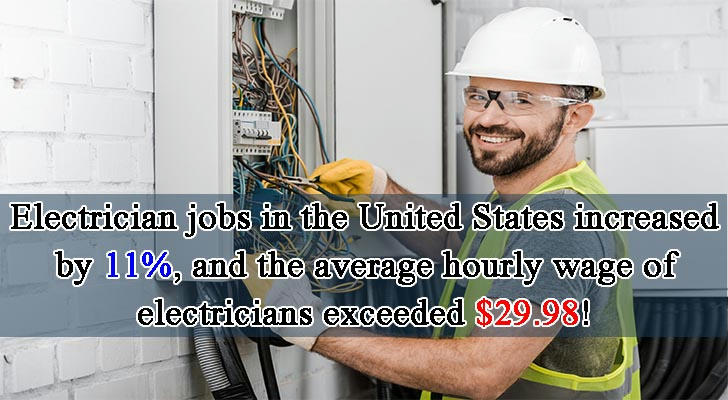⚡ Rising Wages and Unstoppable Demand: Why Electricians Are the ‘Recession-Proof’ Workers of 2025
In the U.S., the demand for electricians is growing rapidly as automation impacts many office jobs. Employment for electricians is expected to grow 11% from 2023 to 2033, much faster than the average for most professions. By 2026, over 80,000 new electrician jobs will be added every year, making electrical work one of the most secure and rewarding careers today.

✅ Key Facts: Electricians’ Rising Pay and Demand
Average Annual Wage (2024): $62,350
Average Hourly Wage: $29.98
Projected Job Growth (2023–2033): +11%
Annual Openings by 2026: 80,200+
Recent Wage Growth: +12%–15% in the last 5 years
States with Highest Demand: California & Texas
🔧 Why Electricians Are in High Demand
Aging Infrastructure: Older buildings need electrical upgrades. For example, cities like San Francisco are modernizing outdated electrical systems.
Energy Efficiency: New buildings and renovations require smart, energy-efficient electrical systems. Many homeowners are opting for solar panel installations, creating more job opportunities.
Green Energy Projects: There is a growing need for electricians due to investments in solar energy, electric vehicle charging stations, and renewable energy projects.
💵 Electrician Wages vs. Office Jobs: The Pay Gap
Electricians now average $29.98/hour, which is significantly higher than many entry-level office jobs paying $18–$22/hour.
Notably, electrician pay has risen by 12%–15% in the last 5 years — faster than many industries — thanks to labor shortages and green energy growth.
For example, in states like California or New York, experienced electricians in specialized fields can earn $45–$50/hour.
🛡️ Job Security: Why Electricians Are Recession-Proof
Electrical work requires hands-on skills and problem-solving that robots cannot replace. Electricians work in different industries, such as residential, commercial, and green energy, ensuring their work remains essential during economic downturns.
For example, even during the 2008 recession, electrical work continued to be in demand due to infrastructure projects and repairs.
📊 States with the Highest Demand for Electricians
| Rank | State | Employed Electricians |
|---|---|---|
| 1️⃣ | California | 73,420 |
| 2️⃣ | Texas | 71,880 |
| 3️⃣ | Florida | 47,980 |
| 4️⃣ | New York | 40,380 |
| 5️⃣ | Ohio | 27,150 |
🔥 California and Texas lead, driven by housing growth, infrastructure projects, and green energy initiatives.
🎓 Training and Career Path: How to Build a Future as an Electrician
Electricians typically start with a paid apprenticeship, where they gain hands-on experience while earning. The National Electrical Contractors Association (NECA) offers some of the best apprenticeship programs.
As the demand for green energy grows, electricians can specialize in areas like solar power or smart grid systems to stay ahead of industry trends.
✅ What Makes a Good Electrician?
Detail-Oriented: Focus on safety and precision.
Hands-On Problem Solver: Able to solve electrical issues on-site.
Independent Worker: Electricians enjoy varied work environments without a cubicle.
📌 How to Apply in 3 Simple Steps
1️⃣ Find a Local Program or Apprenticeship
Look for local trade schools or apprenticeship programs near you.
2️⃣ Submit Your Application
Fill out a simple application form online or at the provider.
3️⃣ Start Earning While You Learn
Start your paid training and gain practical experience.
🚀 Looking Ahead: Continued Growth and Opportunities
With the growth of solar energy, electric vehicle networks, and smart homes, electricians will be in high demand. Continuing education and training in new technologies will help electricians stay competitive.
🏆 Final Thoughts: Why Become an Electrician?
✔️ Competitive Pay — Salaries rose 12%–15% in 5 years and keep climbing.
✔️ Job Security — Work that’s essential and hard to automate.
✔️ Growth Potential — Specialize in green energy and advanced systems.
With growing demand and high pay, becoming an electrician is one of the most stable and future-proof career choices for 2025 and beyond.
